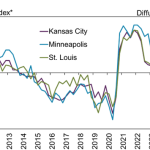Higher food inflation due to production cost increases
After the Labor Department’s Bureau of Labor Statistics reported Sept. 11 that food inflation increased 0.5% in August as the food-at-home index rose 0.6% and the food-away-from-home index increased 0.3%, FMI-The Food Industry Association Vice President of Tax, Trade, Sustainability and Policy Development Andy Harig said in a news release, “The rise in grocery prices after remaining flat in July is likely a result of significant production cost increases in July flowing through the supply chain. Food price inflation continues to experience challenges driven by input costs and market uncertainties.”
FMI Vice President of Research and Insights Steve Markenson added, “Shoppers remain resilient regarding increases in grocery prices. FMI’s September Grocery Shopper Snapshot found that 40% of shoppers expect their household finances to be better a year from now, a four-point increase since April but also four points below its peak in January. The impact of tariffs on grocery prices is shoppers’ top concern, with 57% either very or extremely concerned. Despite these concerns, grocery shoppers remain savvy, as 81% feel in control of their household grocery expenses.”
Harig also said that FMI members “are encouraged by the Trump administration’s recent executive order establishing a zero-tariff rate for country-specific products if certain conditions are met. We are hopeful this positive step will lay the groundwork for broader and more favorable trade conditions. However, we are keeping our eye on other economic pressures that can impact production costs, supply chains, labor availability and consumer purchasing power.”
BLS explained, “All six major grocery store food group indexes increased in August. The index for fruits and vegetables rose 1.6% over the month as the index for tomatoes increased 4.5% and the index for apples rose 3.5%. The meats, poultry, fish and eggs index increased 1.0% in August, with the beef index rising 2.7%. The index for nonalcoholic beverages increased 0.6%, and the index for other food-at-home increased 0.1%. Both the dairy and related products index and the cereals and bakery products index also rose 0.1% in August.
The index for full service meals rose 0.4% over the month, and the index for limited service meals increased 0.1%.
Over the 12 months ending in August, the index for food-at-home rose 2.7%. The meats, poultry, fish, and eggs index rose 5.6% over the last 12 months. The index for nonalcoholic beverages increased 4.6% over the same period and the index for other food-at-home rose 1.5%. The fruits and vegetables index increased 1.9% over the 12 months ending in August. The index for cereals and bakery products rose 1.1%, and the index for dairy and related products increased 1.3% over the same period.
The food-away-from-home index rose 3.9% over the last year. The index for full-service meals rose 4.6%, and the index for limited-service meals rose 3.2% over the same period.
BLS said the Consumer Price Index for All Urban Consumers increased 0.4% on a seasonally adjusted basis in August, after rising 0.2% in July. Over the last 12 months, the all-items index increased 2.9% before seasonal adjustment. The index for shelter rose 0.4% in August and was the largest factor in the all-items monthly increase. The index for energy rose 0.7% in August as the index for gasoline increased 1.9% over the month.





